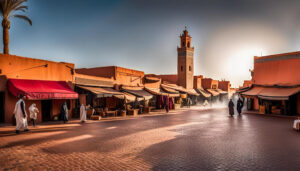s a vibrant hub of culture, history, and adventure. Nestled between the Sahara Desert and the majestic Atlas Mountains, Marrakech is a place where tradition meets modernity, offering a sensory experience unlike any other. From its bustling markets and historic palaces to serene gardens and unique culinary delights, Marrakech is a destination that invites exploration. Here’s a guide to making the most of your visit to this enchanting city.
1. Immerse Yourself in Djemaa el-Fna

No visit to Marrakech is complete without experiencing Djemaa el-Fna, the heart of the city’s cultural and social life. This famous square is an ever-changing theater, buzzing with musicians, storytellers, snake charmers, and street food vendors. As evening falls, the square transforms, with the air filling with the aromas of grilled meats, spices, and fresh juices. Enjoy a cup of mint tea at a rooftop café to take in the vibrant scene from above.
2. Wander Through the Medina Souks
The medina, Marrakech’s old city, is a labyrinth of narrow alleyways and bustling souks (markets). Here, you’ll find artisans selling handcrafted goods, from colorful textiles and rugs to ceramics, jewelry, spices, and more. The souks are organized by specialty, so whether you’re looking for leather goods or fragrant spices, there’s a section dedicated to your desires. Bargaining is part of the experience, so embrace the friendly negotiations with vendors for an authentic experience.
3. Explore Historical and Architectural Marvels
Marrakech’s rich history is reflected in its stunning architecture, with many of its buildings dating back centuries:
- Koutoubia Mosque: The largest mosque in Marrakech, Koutoubia is known for its striking 12th-century minaret. Though non-Muslims cannot enter, the mosque’s exterior and surrounding gardens offer a beautiful sight.
- Bahia Palace: Step into a world of ornate tilework, intricately carved ceilings, and lush gardens. Built in the 19th century, the Bahia Palace was intended to be the grandest palace of its time and remains a prime example of Moroccan architecture.
- Saadian Tombs: Rediscovered in 1917, these tombs date back to the 16th century and serve as the resting place for members of the Saadian dynasty. The tombs’ intricate decorations and peaceful gardens make them a must-see.
4. Relax in Marrakech’s Beautiful Gardens
While Marrakech is famous for its bustling streets, it’s also home to some serene green spaces that provide a welcome respite from the city’s energy:
- Majorelle Garden: Created by French painter Jacques Majorelle and later preserved by Yves Saint Laurent, this garden is a lush haven filled with exotic plants, vibrant blue buildings, and peaceful paths. The on-site Berber Museum is a small but insightful look into Moroccan culture.
- Menara Gardens: Located on the edge of the city, the Menara Gardens are ideal for a leisurely stroll, with a large reflecting pool framed by olive groves and stunning views of the Atlas Mountains in the distance.
5. Savor Moroccan Cuisine
Marrakech’s food scene is as vibrant as its streets, with flavors that reflect the city’s rich history and cultural diversity. Some dishes and dining experiences not to be missed include:
- Tagine: This traditional Moroccan stew, cooked in an earthenware pot, comes in endless variations, from chicken with preserved lemon to lamb with prunes. Enjoy a tagine at a local restaurant for a flavorful experience.
- Couscous: Often served with meat and vegetables, couscous is a staple of Moroccan cuisine and a must-try dish for visitors.
- Mint Tea: Known as “Moroccan whiskey,” mint tea is served throughout the day and is both a symbol of hospitality and a refreshing treat.
For a more immersive experience, consider joining a cooking class to learn the art of preparing traditional Moroccan dishes.
6. Escape to the Atlas Mountains
For travelers looking to explore beyond the city, the Atlas Mountains offer a breathtaking escape into nature. Just a short drive from Marrakech, you’ll find stunning landscapes, hiking trails, and the chance to visit traditional Berber villages. Popular spots like the Ourika Valley and Imlil provide a look into rural Moroccan life and offer unforgettable views of the mountains and valleys.
7. Experience Marrakech by Night
When the sun sets, Marrakech’s energy takes on a new life. In the evening, visit rooftop bars and restaurants for stunning views of the city illuminated by lanterns. For a more traditional night out, consider visiting a local hammam for a relaxing bath and massage experience or catch a performance at one of the city’s cultural centers for live music and dance performances that showcase Morocco’s rich artistic heritage.
Practical Tips for Visiting Marrakech
- Best Time to Visit: Spring (March to May) and autumn (September to November) are ideal for comfortable weather and fewer crowds.
- Dress Modestly: Marrakech is a conservative city, so it’s respectful to dress modestly, especially in the medina.
- Stay Hydrated: Marrakech’s dry climate can be dehydrating, so carry water and take breaks in shaded areas.
- Respect Local Customs: Be mindful of local etiquette, such as asking for permission before taking photos of people and avoiding displays of affection in public.
A City of Endless Discoveries
Marrakech is a city that entices travelers to return again and again, each visit revealing something new. Whether you’re exploring its historic sites, savoring its culinary treasures, or losing yourself in the maze of its souks, Marrakech offers an experience that lingers long after you leave. Embrace its rhythm, and let this timeless city captivate you.

